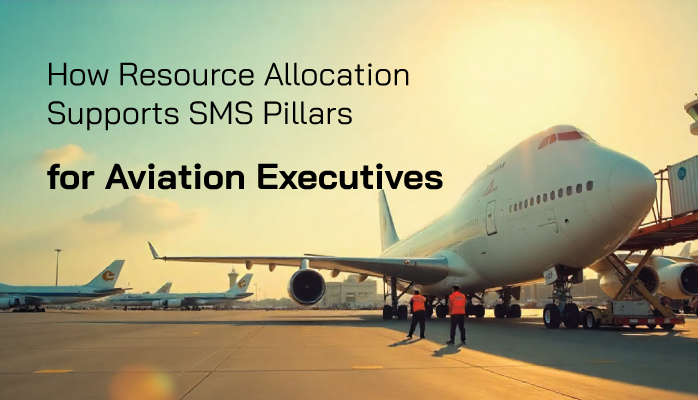Why Safety Managers Fail to Get Budget

For new aviation safety managers, training staff on Safety Management System (SMS) concepts can feel like navigating uncharted skies. The complexity of SMS, combined with the need to engage accountable executives—senior leaders responsible for SMS oversight—often leaves managers unsure of where to begin.
A critical aspect of SMS success is resource allocation, which ensures the system has the financial, human, and technological support needed to function effectively. By understanding how resources bolster each SMS pillar, safety managers can guide executives to make informed decisions and demonstrate compliance with standards set by the International Civil Aviation Organization (ICAO) and national civil aviation authorities like the FAA or EASA.
This evergreen blog article explains how resource allocation supports the four SMS pillars—safety policy, safety risk management, safety assurance, and safety promotion. With practical examples and actionable strategies, this guide empowers aviation safety managers to train staff, engage accountable executives, and build a robust safety culture that stands the test of time.
Why Resource Allocation Is the Backbone of SMS
A Safety Management System is a structured top-down framework for identifying hazards, assessing risks, and implementing risk controls to prevent incidents in aviation operations. The accountable executive—typically the CEO, COO, or a designated senior leader—is responsible for ensuring the SMS is properly resourced. Without adequate funding, trained personnel, or technology, even the best-designed SMS will falter.
The four SMS pillars—safety policy, safety risk management, safety assurance, and safety promotion—rely on resources to function effectively. By allocating budgets, hiring qualified staff, and investing in tools, executives enable each pillar to contribute to safety performance. For new safety managers, explaining this connection is key to training staff and securing executive buy-in. Let’s explore how resources support each pillar, with examples to illustrate their impact.
SMS Pillar 1: Safety Policy and Objectives
The safety policy pillar establishes the organization’s commitment to safety, setting objectives and defining responsibilities. It’s the foundation of SMS, requiring resources to develop, communicate, and maintain.
How Resources Support Safety Policy
- Financial Resources: Budgets fund the creation of a safety policy, including legal reviews to ensure compliance with ICAO Annex 19 or FAA Part 5. Funds also support communication tools, like posters or digital platforms, to share the policy with employees.
- Human Resources: Qualified safety personnel draft and update the policy, while trainers educate staff on its principles. The accountable executive’s time is also a resource, as their endorsement signals leadership.
- Technological Resources: Software platforms host the policy for easy access, and intranet systems facilitate company-wide distribution.
Example
A regional airline allocates $10,000 annually to develop and communicate its safety policy. This budget covers hiring a safety consultant to draft a policy aligned with FAA Part 5, printing posters for crew rooms, and licensing an intranet platform to share the policy with 500 employees. The accountable executive attends a two-hour training session to understand their role and signs the policy, reinforcing its importance.
Why It Works
This example shows how financial, human, and technological resources enable the safety policy to be developed, communicated, and endorsed, ensuring all staff understand the organization’s safety commitment.
Actionable Tip: Create a safety policy budget proposal for the accountable executive, detailing costs for consultants, communication tools, and training. Present it during a strategic planning meeting to secure approval.
SMS Pillar 2: Safety Risk Management

Safety risk management (SRM) involves identifying hazards, assessing risks, and implementing risk controls. It’s the heart of SMS, requiring robust resources to analyze data and mitigate risks effectively.
How Resources Support Safety Risk Management
- Financial Resources: Budgets fund risk assessment tools, such as software for bow-tie diagrams or risk matrices, and mitigation measures, like equipment upgrades or procedure changes.
- Human Resources: Trained safety analysts conduct hazard identification and risk assessments. Frontline staff, such as pilots or mechanics, contribute by reporting hazards, requiring time and training to do so effectively.
- Technological Resources: Hazard reporting systems, data analytics platforms, and predictive modeling tools streamline SRM processes, enabling faster and more accurate risk analysis.
Example
An airport operator invests $50,000 in a cloud-based hazard reporting system that allows ground crew to report issues like runway debris via a mobile app. The safety team, trained in risk assessment, uses the system’s analytics to prioritize high-severity hazards, such as wildlife incursions. The accountable executive approves a $20,000 budget to install bird deterrent systems, reducing the risk of bird strikes by 30% within six months.
Why It Works
This example highlights how financial investment in technology, combined with trained personnel and executive approval, enables effective hazard identification and risk mitigation, directly supporting SRM.
Actionable Tip: Propose SMS Pro hazard reporting app to the accountable executive, emphasizing its cost-effectiveness and impact on risk reduction. Include a demo to show how it simplifies reporting for staff.
SMS Pillar 3: Safety Assurance
Safety assurance monitors SMS performance through audits, data analysis, and corrective actions. It ensures the system remains effective and compliant, relying heavily on resources to track and improve safety outcomes.
How Resources Support Safety Assurance
- Financial Resources: Budgets cover internal and external audits, data analysis software, and corrective action implementation, such as process updates or additional training.
- Human Resources: Auditors and safety analysts review performance data, while managers implement corrective actions. Staff time is needed to participate in audits and provide feedback.
- Technological Resources: Safety dashboards visualize key performance indicators (KPIs), like incident rates or audit findings, while audit management software tracks compliance and corrective actions.
Example
A maintenance organization allocates $30,000 for an SMS audit program, including $15,000 for an external auditor and $15,000 for a safety dashboard. Two safety analysts, trained in data analysis, spend 20 hours monthly reviewing KPIs, such as maintenance error rates. When an audit identifies gaps in tool calibration procedures, the accountable executive approves $10,000 to train technicians and update equipment, reducing errors by 25%.
Why It Works
This example demonstrates how financial, human, and technological resources enable audits, data monitoring, and corrective actions, ensuring SMS performance is continuously evaluated and improved.
Actionable Tip: Develop a sample safety dashboard with 3–5 KPIs, such as hazard report volume or audit completion rates, and share it with the accountable executive to illustrate the value of data-driven assurance.
SMS Pillar 4: Safety Promotion

Safety promotion fosters a safety culture through training, communication, and engagement. It ensures all employees understand SMS and their role in it, requiring resources to educate and motivate staff.
How Resources Support Safety Promotion
- Financial Resources: Budgets fund SMS training programs, safety campaigns, and recognition programs for employees who contribute to safety goals.
- Human Resources: Trainers deliver SMS education, while safety managers create communication materials, like newsletters or videos. The accountable executive’s participation in safety events reinforces leadership.
- Technological Resources: E-learning platforms deliver training, and communication tools, like email systems or apps, share safety updates and success stories.
Example
A cargo airline invests $25,000 in a safety promotion campaign, including $10,000 for an e-learning platform to train 300 employees on SMS concepts and $15,000 for a “Safety Star” program. The safety manager produces a monthly newsletter highlighting hazard reports that led to improvements, such as updated loading procedures. The accountable executive hosts a quarterly safety town hall, streamed via a video platform, to recognize top contributors, boosting employee engagement by 40%.
Why It Works
This example shows how financial, human, and technological resources support training, communication, and recognition, embedding a safety culture across the organization.
Actionable Tip: Propose a low-cost safety promotion initiative, like a monthly safety bulletin or a recognition program, to the accountable executive. Highlight its impact on employee morale and SMS awareness.
Engaging Accountable Executives in Resource Allocation
For accountable executives, understanding how resources support SMS pillars is critical to prioritizing investments. New safety managers can facilitate this by:
- Presenting Clear Budget Proposals: Outline costs and benefits for each pillar, such as how a hazard reporting system supports SRM or how training boosts safety promotion.
- Demonstrating ROI: Show how resources reduce risks, prevent incidents, and enhance compliance, saving costs in the long term. For example, a $20,000 investment in bird deterrents may prevent a $1 million engine repair.
- Involving Executives in Decisions: Invite the accountable executive to review resource plans and approve key investments, reinforcing their role in SMS oversight.
Actionable Tip: Schedule a 30-minute briefing with the accountable executive to present a resource allocation plan, using the examples above to illustrate how investments support each pillar.
Overcoming Training Challenges
New safety managers often struggle to train staff on SMS due to its complexity. Here’s how to use resource allocation as a training focus:
- Simplify Concepts: Explain resources as the “fuel” that powers each SMS pillar, using analogies like a plane needing fuel, crew, and navigation systems to fly safely.
- Use Real-World Examples: Share stories of how resources led to safety improvements, like the airport’s bird deterrent system or the airline’s training platform.
- Leverage Visual Aids: Create infographics showing how budgets, staff, and technology support each pillar, making it easier for staff to grasp.
Actionable Tip: Develop a one-page handout summarizing how resources support the four SMS pillars, with examples, and distribute it during training sessions.
Related Aviation SMS Training Articles
- What Is Aviation Safety Training in Aviation SMS - Includes Videos to Use
- Why Employees Can’t Stand Aviation SMS Training
- 4 Pillars | 10 Things You Need to Know About Aviation Safety Training
Demonstrating Compliance Through Resources
Regulators, such as the FAA or EASA, assess whether organizations allocate sufficient resources to SMS. Accountable executives can demonstrate compliance by:
- Documenting Investments: Keep records of budgets, training logs, and technology purchases, showing how they support each pillar.
- Participating in Audits: Be present during regulatory audits to discuss resource allocation and its impact on SMS performance.
- Sharing Success Stories: Highlight how resources led to measurable outcomes, like reduced incident rates or improved audit scores, in regulatory reports.
Actionable Tip: Create a resource allocation report summarizing investments in each SMS pillar and share it with regulators during inspections to demonstrate compliance.
Conclusion: Powering SMS With Strategic Resources
Resource allocation is the lifeblood of a successful Safety Management System, enabling each pillar—safety policy, safety risk management, safety assurance, and safety promotion—to thrive. By understanding and communicating how financial, human, and technological resources support these pillars, aviation safety managers can train staff effectively and guide accountable executives to make informed decisions.
For new safety managers, this guide provides a clear starting point to demystify SMS and engage leadership. Start by assessing your organization’s resource needs and presenting a plan to the accountable executive, using the examples above as inspiration. With strategic investments, you’ll build a safety culture that protects lives, assets, and your organization’s reputation for years to come.
Call to Action: Ready to strengthen your SMS? Collaborate with your accountable executive to allocate resources for each SMS pillar. Share this article with your team to spark discussions on safety investments today.








